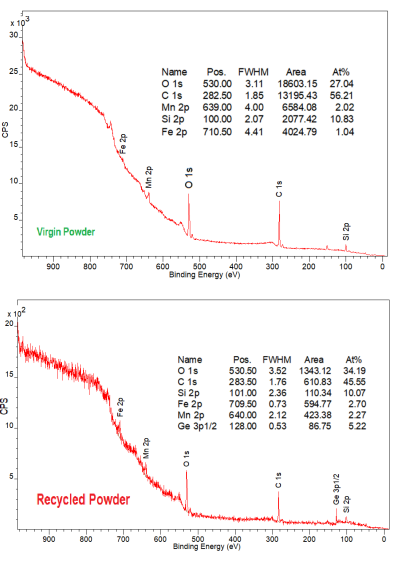Authors N.E. Gorji, R. O’Connor, and D. Brabazon are studying metal powders in the recently published ‘XPS, XRD, and SEM characterization of the virgin and recycled metallic powders for 3D printing applications.’ Recycling continues to be an ongoing topic in the 3D printing realm as so much material is being consumed and then often discarded due to defects or other structural problems. And while obviously there is a push to re-use as much material as possible—reducing the footprint of manufacturing processes around the world—quality, performance, and functionality are key too.

SEM images from the recycled powder (in 20 m and 10 m zoom) indicating the elongated particles, satellites on the surface, spatter, bonded particles and particles with irregular shapes.
For this study, the authors used virgin feedstock and recycled stainless steel 316L for selective laser melting processes. Characterizing surface and microstructure of both powders, the researchers used X-ray photoemission spectroscopy (XPS), scanning electron microscopy (SEM), X-ray diffraction (XRD) and rheology analysis. Along with examining and comparing both types of powder, the researchers also considered using virgin powder as an additive if recycled powders required further mechanical strength.
Characterization studies were offered for both to make certain they were reproducible, with SEM results showing a slight difference in powder after the SLM process, recycled powder showing more satellite on the surface, with more contamination. Bonded particles were also found in the recycled powder, with some deformed particles.
“Several features are observed in the recycled powders such as elongated particles, satellites on surface, spatter, bonded particles and particles with irregular shapes,” said the researchers. “Overall, the morphology of the recycled powder shows insignificant changes. However, XPS characterization can better reveal the presence of various elements on the surface of the powders especially on the recycled powder.”
Oxygen levels increased, per XPS measurements from 27.04% to 34.19%, with uptake dependent on powder production. Carbon was reduced from 56% to 45.55%, possibly due to domination of metallic oxides on the surface. The researchers point out that some metal powder, possessing more electronegativity to oxygen, could spread to the outer surface of the powder—thus absorbing oxygen during SLM.
“The presence of heavy metals on the surface such as Ge (5.22%) and Sb (2.86%) is also surprising and is under further examinations,” stated the researchers, going on to recommend mixing virgin powder with the reused powder after five cycles.
“The SEM images show more satellites on recycled powders and XPS measurements show that the metal oxides are slightly increasing on its surface as well. Oxygen is showing the most increment on surface increasing from 27.04% to 34.19%,” concluded the researchers. “The XRD result show no change on the phase of the recycled austenitic stainless steel compared to virgin powder. There are no additional ferritic BCC peaks on recycled powder indicating a low contamination and phase change after SLM process. “
As the study of materials continues to progress in 3D printing, researchers have put enormous focus on metal—from copper to titanium to metal-polymers. What do you think of this news? Let us know your thoughts! Join the discussion of this and other 3D printing topics at 3DPrintBoard.com.
[Source / Images: ‘XPS, XRD, and SEM characterization of the virgin and recycled metallic powders for 3D printing applications’]
Subscribe to Our Email Newsletter
Stay up-to-date on all the latest news from the 3D printing industry and receive information and offers from third party vendors.
You May Also Like
Gorilla Sports GE’s First 3D Printed Titanium Cast
How do you help a gorilla with a broken arm? Sounds like the start of a bad joke a zookeeper might tell, but it’s an actual dilemma recently faced by...
Nylon 3D Printed Parts Made More Functional with Coatings & Colors
Parts 3D printed from polyamide (PA, Nylon) 12 using powder bed fusion (PBF) are a mainstay in the additive manufacturing (AM) industry. While post-finishing processes have improved the porosity of...
$25M to Back Sintavia’s Largest Expansion of Metal 3D Printing Capacity Since 2019
Sintavia, the digital manufacturing company specializing in mission-critical parts for strategic sectors, announced a $25 million investment to increase its production capacity, the largest expansion to its operations since 2019....
Velo3D Initiates Public Offering in a Bid to Strengthen Financial Foundations and Drive Future Growth
Velo3D (NYSE: VLD) has been among a number of publicly traded 3D printing firms that have attempted to weather the current macroeconomic climate. After posting a challenging financial report for 2023,...


































